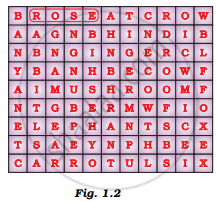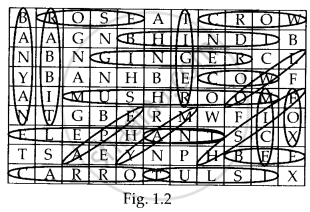Advertisements
Advertisements
प्रश्न
Spot as many organisms as possible in the puzzle given in Figure 1.2 by encircling them as shown. Write the names on a sheet of paper and categorise them into autotrophs and heterotrophs. Classify the heterotrophs into herbivores, carnivores, omnivores and saprophytes.

उत्तर

Autotrophs: rose, mango, bhindi, carrot, banyan, tulsi, ginger, yam
Heterotrophs: elephant, ant, yeast, tiger, mushroom, fox, mice, owl, cow, cow, rabbit, beef, fish, ape
Herbivores: elephant, cow, rabbit, bee
Carnivores: tiger
Omnivores: ant, mice, owl, crow, fox, ape
Saprophytes: mushroom, yeast
Note: Fish can be herbivores, carnivores or omnivores depending on the species.
APPEARS IN
संबंधित प्रश्न
Name an animal whose process of obtaining food is called phagocytosis.
Arrange the following processes involved in the nutrition in animals in the correct order (in which they take place):
Assimilation, Egestion, Ingestion, Absorption, Digestion
Fill in the following blank with suitable word :
All non-green plants and animals are ....................
Fill in the following blank with suitable word :
Heterotrophs depend on .................... and other .................... for food.
Organisms that cannot prepare their own food.
What are herbivores, carnivores and omnivores? Give two examples of each.
The correct order of steps occurring in nutrition in animals is:
(a) Ingestion → Absorption → Digestion → Assimilation → Egestion
(b) Ingestion → Digestion → Assimilation → Absorption → Egestion
(c) Ingestion → Digestion → Absorption → Assimilation → Egestion
(d) Ingestion → Assimilation → Digestion → Absorption → Egestion
A unicellular animal P having no fixed shape ingests a food particle by forming temporary finger-like projections Q. The food particle is engulfed with a little surrounding water to form a temporary stomach R inside it. The chemicals S from surrounding cytoplasm enter into R and break down food into small and soluble molecules by chemical reactions. The digested food is absorbed directly into cytoplasm by the process T. The undigested food is thrown out of the body by the rupture of a cell organelle U in a process called V.
(a) Name the unicellular animal P.
(b) What are (i) Q, and (ii) R?
(c) Name (i) chemical S, and (ii) process T.
(d) Name (i) organelle U, and (ii) process V.
In which mode of nutrition an organism derives its food from the body of another living organism without killing it?
Generally, food is broken and absorbed within the body of organisms. In which of the following organisms is it done outside the body?
